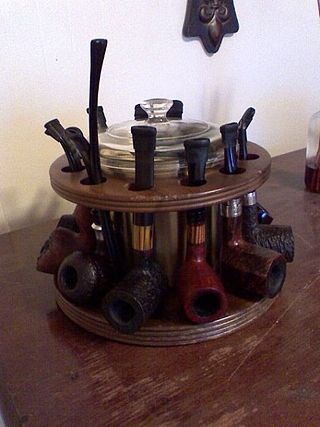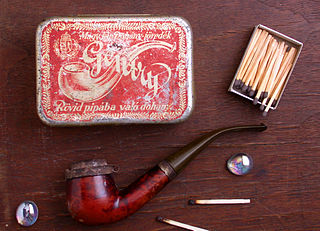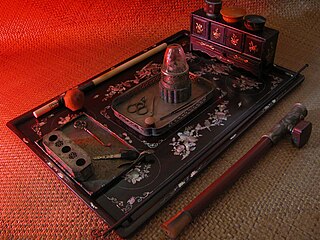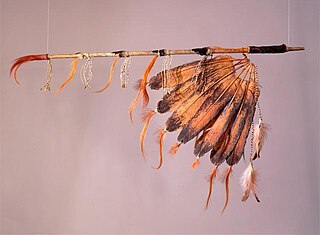
A tobacco pipe, often called simply a pipe, is a device specifically made to smoke tobacco. It comprises a chamber for the tobacco from which a thin hollow stem (shank) emerges, ending in a mouthpiece. Pipes can range from very simple machine-made briar models to highly prized hand-made artisanal implements made by renowned pipemakers, which are often very expensive collector's items. Pipe smoking is the oldest known traditional form of tobacco smoking.

A bong is a filtration device generally used for smoking cannabis, tobacco, or other herbal substances. In the bong shown in the photo, the smoke flows from the lower port on the left to the upper port on the right.

A hookah, shisha, or waterpipe is a single- or multi-stemmed instrument for heating or vaporizing and then smoking either tobacco, flavored tobacco, or sometimes cannabis, hashish and opium. The smoke is passed through a water basin—often glass-based—before inhalation.

A chillum, or chilam, is a straight conical smoking pipe traditionally made of clay or a soft stone. Examples of chillum were found in Pre-Columbian America, and it would evolve eventually into the "elbow-pipe". It was used popularly in India in the eighteenth century. A small stone is often used as a stopper in the stem. The style of pipe spread to Africa, and has been known in the Americas since the 1960s. A chillum pipe is used in Rastafari rituals.

A chibouk is a very long-stemmed Turkish tobacco pipe, often featuring a clay bowl ornamented with precious stones. The stem of the chibouk generally ranges between 4 and 5 ft., much longer than even Western churchwarden pipes. While primarily known as a Turkish pipe, the chibouk was once popular in Iran, as well.

Pipe smoking is the practice of tasting the smoke produced by burning a substance, most commonly tobacco and cannabis, in a pipe. It is the oldest traditional form of smoking.
A gravity bong, also known as a GB, bucket bong, grav, geeb, yoin, or ghetto bong, is a method of consuming smokable substances such as cannabis. The term describes both a bucket bong and a waterfall bong, since both use air pressure and water to draw smoke. A lung uses similar equipment but instead of water draws the smoke by removing a compacted plastic bag or similar from the chamber.

A midwakh' is a small smoking pipe of Arabian origin, in which dokha (دوخة), a sifted Iranian tobacco product mixed with aromatic leaf and bark herbs, is smoked. The bowl of a midwakh pipe is typically smaller than that of a traditional western tobacco pipe. It is usually loaded by dipping the bowl into a container of dokha flakes.

Cannabis smoking is the inhalation of smoke or vapor released by heating the flowers, leaves, or extracts of cannabis and releasing the main psychoactive chemical, Δ9-tetrahydrocannabinol (THC), which is absorbed into the bloodstream via the lungs. Archaeological evidence indicates cannabis with high levels of THC was being smoked at least 2,500 years ago.

A bowl, when referred to in pipe smoking, is the part of a smoking pipe or bong that is used to hold tobacco, cannabis, or other substances.

An opium den was an establishment in which opium was sold and smoked. Opium dens were prevalent in many parts of the world in the 19th century, most notably China, Southeast Asia, North America, and France. Throughout the West, opium dens were frequented by and associated with the Chinese because the establishments were usually run by Chinese mobsters, who supplied the opium and prepared it for visiting non-Chinese smokers. Most opium dens kept a supply of opium paraphernalia such as the pipes and lamps that were necessary to smoke the drug. Patrons would recline to hold the long opium pipes over oil lamps that would heat the drug until it vaporized, allowing the smoker to inhale the vapors. Opium dens in China were frequented by all levels of society, and their opulence or simplicity reflected the financial means of the patrons. In urban areas of the United States, particularly on the West Coast, there were opium dens that mirrored the best to be found in China, with luxurious trappings and female attendants. For the working class, there were many low-end dens with sparse furnishings.

Dottle is the remaining plug of unburnt tobacco and ashes left in the bottom of a tobacco pipe when it has been smoked.

A smoking pipe is used to inhale the smoke of a burning substance; most common is a tobacco pipe, which can also accommodate almost any other substance. Pipes are commonly made from briar, heather, corn, meerschaum, clay, cherry, glass, porcelain, ebonite and acrylic.

A one-hitter is typically a slender pipe with a screened narrow bowl designed for a single inhalation, or "hit", of smoke or vapor from a small serving of heated cannabis flower, tobacco leaf or other dry, sifted herbal preparation. It is distinguished from western-style large-bowl pipes designed for strong tobaccos that are burned hot and tasted but not inhaled. Instead, by properly distancing a lighter flame below the opening, inhalant users operate at vaporization temperatures, minimizing combustion waste and toxicity.

An opium lamp is an oil lamp designed specifically to facilitate the vaporization and inhalation of opium. Opium lamps differ from conventional lamps for lighting in that they are designed to channel an exact amount of heat upward through their funnel-shaped chimneys. An opium pipe, its pipe-bowl primed with a small dose of opium known as a "pill," was held over the opium lamp causing the opium to vaporize and allowing the smoker to inhale the vapors.

Smoking is a practice in which a substance is burned and the resulting smoke is typically breathed in to be tasted and absorbed into the bloodstream. Most commonly, the substance used is the dried leaves of the tobacco plant, which have been rolled into a small rectangle of rolling paper to create a small, round cylinder called a cigarette. Smoking is primarily practised as a route of administration for recreational drug use because the combustion of the dried plant leaves vaporizes and delivers active substances into the lungs where they are rapidly absorbed into the bloodstream and reach bodily tissue. In the case of cigarette smoking, these substances are contained in a mixture of aerosol particles and gases and include the pharmacologically active alkaloid nicotine; the vaporization creates heated aerosol and gas into a form that allows inhalation and deep penetration into the lungs where absorption into the bloodstream of the active substances occurs. In some cultures, smoking is also carried out as a part of various rituals, where participants use it to help induce trance-like states that, they believe, can lead them to spiritual enlightenment.

Cannabis consumption refers to the variety of ways cannabis is consumed, among which inhalation and ingestion are most common. All consumption methods involve heating the plant's THCA to decarboxylate it into THC, either at the time of consumption or during preparation. Salves and absorption through the skin (transdermal) are increasingly common in medical uses, both of CBD, THC, and other cannabinoids. Each method leads to subtly different psychoactive effects due to the THC and other chemicals being activated, and then consumed through different administration routes. It is generally considered that smoking, which includes combustion toxins, comes on quickly but lasts for a short period of time, while eating delays the onset of effect but the duration of effect is typically longer. In a 2007 ScienceDaily report of research conducted at the University of California–San Francisco, researchers reported that vaporizer users experience the same biological effect, but without the toxins associated with smoking. Δ9-THC is the primary component when inhaled, but when eaten the liver converts this to the more psychoactive 11-hydroxy-THC form.

The history of smoking dates back to as early as 5000 BC in the Americas in shamanistic rituals. With the arrival of the Europeans in the 16th century, the consumption, cultivation, and trading of tobacco quickly spread. The modernization of farming equipment and manufacturing increased the availability of cigarettes following the reconstruction era in the United States. Mass production quickly expanded the scope of consumption, which grew until the scientific controversies of the 1960s, and condemnation in the 1980s.

A ceremonial pipe is a particular type of smoking pipe, used by a number of cultures of the indigenous peoples of the Americas in their sacred ceremonies. Traditionally they are used to offer prayers in a religious ceremony, to make a ceremonial commitment, or to seal a covenant or treaty. The pipe ceremony may be a component of a larger ceremony, or held as a sacred ceremony in and of itself. Indigenous peoples of the Americas who use ceremonial pipes have names for them in each culture's Indigenous language. Not all cultures have pipe traditions, and there is no single word for all ceremonial pipes across the hundreds of diverse Native American languages.

The Amsterdam Pipe Museum is a museum in Amsterdam, the Netherlands, dedicated to smoking pipes, tobacco, and related paraphernalia. It holds the national reference collection in these areas.


















